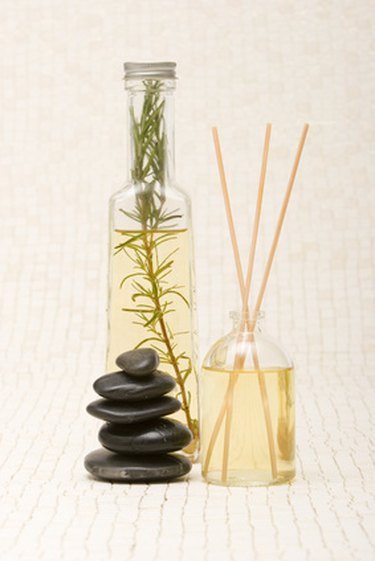Things You'll Need
Pressure cooker
Plant of your choice (ex: lavender, chamomile)
1 foot of rubber tubing (long enough to reach from the pressure cooker to the container)
Small container
Water (at least one cup)

The scent of a room or a particular person can leave a lasting impression and can make or break the mood when entertaining. In the historical masterpiece "Book of the Chemistry of Perfume," which was written by Alkindus, an Arab philosopher and scientist who is widely recognized as the father of the perfume industry, the many ways in which natural oils and plants can produce amazing and memorable scents is discussed in great detail. Today, extracting the essential oils from plants can be done easily at home with the help of a pressure cooker.
Designing Your Distiller
Step 1
Clean a small container to hold the essential oils you will be creating. Place the container on the counter near the stove you will be using.
Video of the Day
Step 2
Pour a few cups of water into the pressure cooker and place it on the burner next to the small container.
Step 3
Place the rubber tubing securely over the pressure release post on the lid of the pressure cooker. The steam will pass through the plants and travel through the rubber tubing, so make sure the tubing is tightly secured around the release post. Place the other end of the tube into the clean container on the counter.
Distilling for Essential Oils
Step 1
Place the portion of the plant you will be extracting the oils from into the pressure cooker with the water.
Step 2
Secure the pressure cooker lid and carefully check the position of the rubber tubing, making sure it empties into the collection container, before turning the burner up to medium heat. Upon boiling, the steam will release the oils into the collection container.
Step 3
Continue the distilling process until you have created the desired amount of essential oils. The oils will remain separated at the top of the collection container, while the bottom layer will be water that was also condensed through the process.
Step 4
Skim the oil off into a separate container using a spoon. It is now ready to use.
Tip
Once you have grasped the concept of distilling oils and feel confident, consider experimenting with new plants. This can easily create a wide variety of amazing new oil scents.
Warning
Never leave the distiller unattended. If the tubing is not secure, it could result in a loss of oils or pose a fire hazard.
Take the time to really understand the plants you are using, as some plants may not produce a desirable scent.
Video of the Day